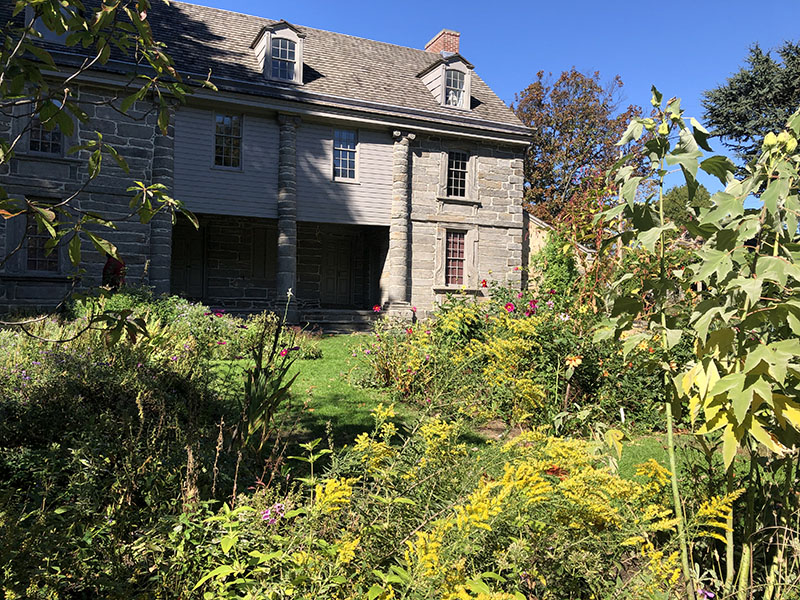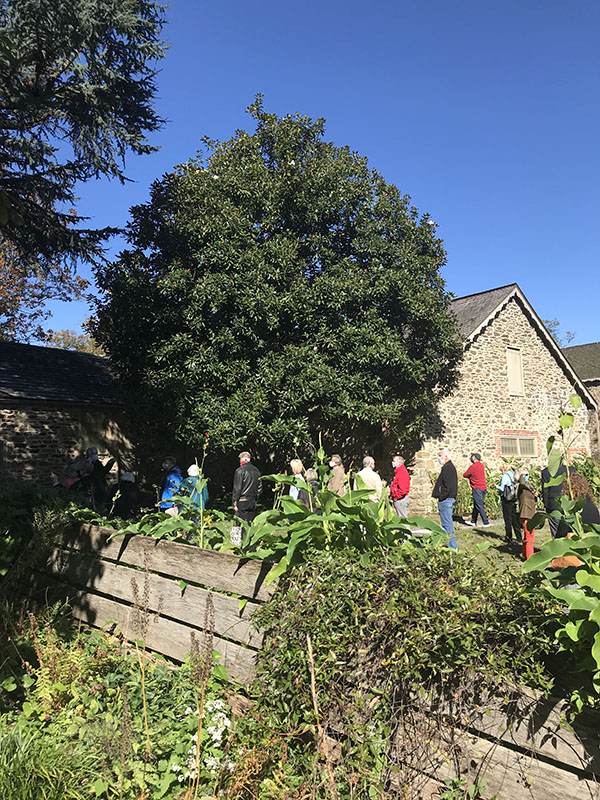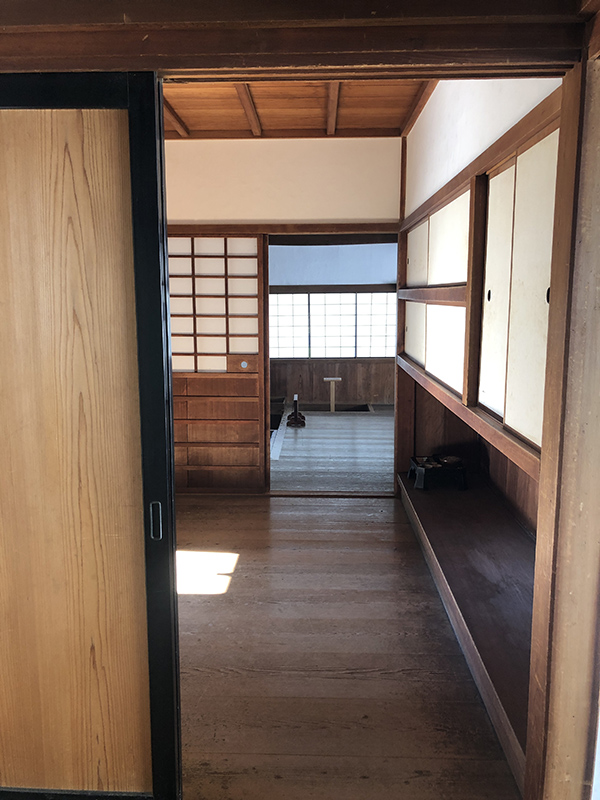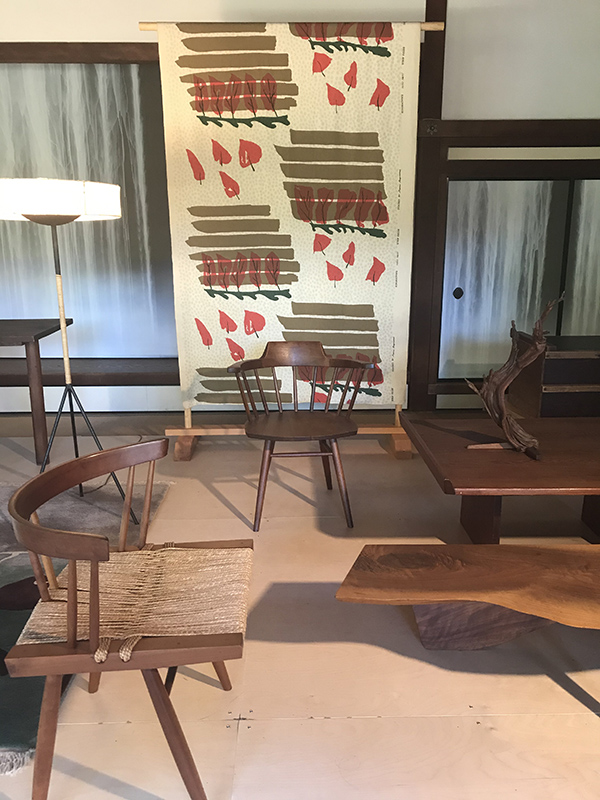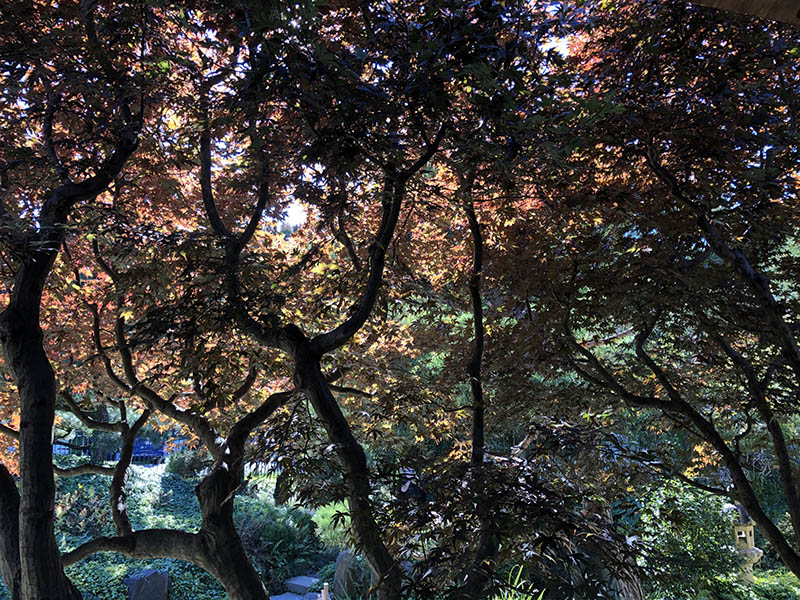Exploring Philadelphia Gardens in Fall: International Influence in Landscape and Design
by Carrie Greif
FOR OUR FIRST IN-PERSON PROGRAM since the beginning of the pandemic, the Trust went outdoors to appreciate two of Philadelphia’s greatest gardens and to find decorative beauty all around. While we were local to our home base in Media, PA, our day was filled with an international scope of plants, architectural styles, and decorative arts.
We gathered on a crisp October morning at Bartram’s Garden, one of the oldest and most significant gardens in the Northern Hemisphere, for a tour with curator Joel Fry. The site has featured an important botanical collection since it was purchased by John Bartram (1699–1777) in 1728. A man of many talents, Bartram was a third-generation Pennsylvania Quaker who used his curiosity and reverence for nature, as well as a passion for scientific inquiry, to surround his stone house with the most varied collection of North American plants in the world (figure 1).
His botanical collection capitalized on the fascination of 18th-century Europeans for North American plants. A revolution in garden aesthetics in early-18th-century England led to the prominence of landscapes modeled after Classical rural villas. In self-conscious recreation, the British variants operated on an expanded scale that viewed all nature as a garden. These large green spaces were filled with exotics from early colonial exploration. North American trees and shrubs offered a new palette for these landscapes and were in high demand thanks to explorer botanists like Bartram, who traveled the continent collecting rare seeds that would be shipped and cultivated in these massive estate gardens. For around five guineas per box Bartram sent international clients 100 to 105 seeds of different North American tree and shrub species. Using this model, he successfully turned scientific curiosity into a profitable and prolific business (figure 2).
Bartram introduced many species to the European continent. Among his most significant finds was the “Great mountain Magnolia” or Magnolia acuminata. Bartram discovered this flowering tree on his trip to Onondaga, Oswego, and Lake Ontario in 1743. In 1762, nearly two decades after it was planted in England by Peter Collison, a close acquaintance of Bartram, the tree finally flowered, likely the first of that species ever to do so there. Bartram changed the cultivated landscapes of England and spurred cross-cultural botanical exchange for generations to come (figure 3).
By the end of his life, Bartram had access to 200–225 species of North American plants, and his seed business had expanded to include the sales of live plants to local and then to international clients. Four generations of the Bartram family ran the site as a botanic garden and continued its legacy as a horticultural hub. Today the 45-acre National Historic Landmark, situated within what is now an industrial and residential section of the city, offers a variety of programs that continue the intent of the site to cultivate botanical study and appreciation.
In the afternoon, our exploration of international influence in landscapes transitioned from the colonial to the modern and contemporary at Shofuso House in Fairmount Park, a venue that embodies the relationship between naturalistic Japanese design and mid-20th-century Modernism. “The garden was designed to be seen from the inside,” curator Yuka Yokoyama informed our group as we stood underneath a weeping cherry tree while enjoying the subtle waterfall beyond the garden’s island. The garden setting was striking and serene, and Yokoyama referred our group to the architectural details that enrich the relationship between Shofuso House and the exterior space (figure 4).
In Japanese architecture, nature is fully integrated and harmoniously mirrored. The floor-to-ceiling windows and sliding doors that comprise Shofuso House are designed to create a sense of unity with nature. In this way, the architectural elements are utilized as a tool to remove the separation between the indoors and outdoors.
Shofuso House has a history of exemplifying the Japanese way of living. Shofuso, which translates to Pine Breeze Villa, is modeled after a traditional 17th-century Japanese house. Constructed in 1953, only eight years after the Japanese surrender that ended World War II, the house was originally installed as part of a series of model homes in the sculpture garden at the Museum of Modern Art in New York City. Standing in West Fairmount Park since 1958, the structure was initially called the Japanese Exhibition House and today is often referred to as the Japan House.
Shofuso’s legacy of relating Japanese architecture to modern design principles is further embodied in the current exhibition, Shofuso and Modernism: Mid-Century Collaboration between Japan and Philadelphia. Curator William Whitaker led Trust participants through the exhibition that he co-curated with Yokoyama. The exhibition celebrates the friendships and transcultural exchanges among Shofuso’s Japanese architect Junzo Yoshimura (1908–1997), Japanese American woodworker George Nakashima (1905–1990), Swiss American designer Noémi Pernessin Raymond (1889–1980), and Czech American architect Antonin Raymond (1888–1976).
Whitaker highlighted objects displayed in the traditional Japanese tea room that spoke to the integration of Japanese design principles in Modernist objects. For example, Nakashima’s Grass Seated Chair (1944–1955) would not be present in a traditional tea room setting where tatami mats serve as a comfortable space for seating. Fry noted, however, that these chairs relate to Japanese principles, particularly in the application of raw, unfinished wood and grass. This honesty to material and reflection of nature is central to both Modernism and Japanese aesthetics. These objects exhibited within the context of Shofuso House further the spirit of the site as an embodiment of creative exchanges (figure 5).
Although very different, both sites express how essential international collaboration is to the evolution of decorative art forms. The Trust cannot currently travel internationally, but our passion for decorative arts can allow us to experience the evolving influences present in our built environment. Philadelphia Gardens in Fall was a timely reminder of the power of decorative arts to build communities and economies while cultivating a more wonderful world in which to live (figure 6).
Carrie Greif is the Programming Coordinator at the Decorative Arts Trust.
A print version of this article was published in The Magazine of the Decorative Arts Trust, one of our most popular member benefits. Join today!

